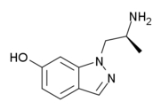
AL-34662
Encyclopedia
AL-34662 is an indazole
derivative drug that is being developed for the treatment of glaucoma
. It acts as a selective 5-HT2A
receptor
agonist
, the same target as that of hallucinogenic drugs like psilocin
, but unlike these drugs, AL-34662 was designed specifically as a peripherally selective drug, which does not cross the blood-brain barrier
. This means that AL-34662 can exploit a useful side effect of the hallucinogenic 5-HT2A agonists, namely reduction in intra-ocular pressure and hence relief from the symptoms of glaucoma, but without causing the hallucinogenic effects that make centrally active 5-HT2A agonists unsuitable for clinical use. In animal studies, AL-34662 has been shown to be potent and effective in the treatment of symptoms of glaucoma, with minimal side effects.
Peripherally acting 5-HT2A agonists have been a rich field of research in recent years, with potential glaucoma treatments being the main proposed application for 5-HT2A agonists at present, as centrally acting agonists for this receptor tend to be hallucinogenic and thus have little medical use. While many novel, potent and selective 5-HT2A agonists have been developed for this application, retaining peripheral selectivity can be a problem, and several of the more lipophilic
compounds closely related to AL-34662 such as those shown below, did cross the blood-brain barrier and produced hallucinogen-appropriate responding in animals.

Indazole
Indazole, also called benzpyrazole or isoindazone, is a heterocyclic aromatic organic compound.Indazole derivatives display a broad variety of biological activities....
derivative drug that is being developed for the treatment of glaucoma
Glaucoma
Glaucoma is an eye disorder in which the optic nerve suffers damage, permanently damaging vision in the affected eye and progressing to complete blindness if untreated. It is often, but not always, associated with increased pressure of the fluid in the eye...
. It acts as a selective 5-HT2A
5-HT2A receptor
The mammalian 5-HT2A receptor is a subtype of the 5-HT2 receptor that belongs to the serotonin receptor family and is a G protein-coupled receptor . This is the main excitatory receptor subtype among the GPCRs for serotonin , although 5-HT2A may also have an inhibitory effect on certain areas such...
receptor
Receptor (biochemistry)
In biochemistry, a receptor is a molecule found on the surface of a cell, which receives specific chemical signals from neighbouring cells or the wider environment within an organism...
agonist
Agonist
An agonist is a chemical that binds to a receptor of a cell and triggers a response by that cell. Agonists often mimic the action of a naturally occurring substance...
, the same target as that of hallucinogenic drugs like psilocin
Psilocin
Psilocin , an aromatic compound, sometimes also spelled psilocine, psilocyn, or psilotsin, is a psychedelic mushroom alkaloid. It is found in most psychedelic mushrooms together with its phosphorylated counterpart psilocybin...
, but unlike these drugs, AL-34662 was designed specifically as a peripherally selective drug, which does not cross the blood-brain barrier
Blood-brain barrier
The blood–brain barrier is a separation of circulating blood and the brain extracellular fluid in the central nervous system . It occurs along all capillaries and consists of tight junctions around the capillaries that do not exist in normal circulation. Endothelial cells restrict the diffusion...
. This means that AL-34662 can exploit a useful side effect of the hallucinogenic 5-HT2A agonists, namely reduction in intra-ocular pressure and hence relief from the symptoms of glaucoma, but without causing the hallucinogenic effects that make centrally active 5-HT2A agonists unsuitable for clinical use. In animal studies, AL-34662 has been shown to be potent and effective in the treatment of symptoms of glaucoma, with minimal side effects.
Peripherally acting 5-HT2A agonists have been a rich field of research in recent years, with potential glaucoma treatments being the main proposed application for 5-HT2A agonists at present, as centrally acting agonists for this receptor tend to be hallucinogenic and thus have little medical use. While many novel, potent and selective 5-HT2A agonists have been developed for this application, retaining peripheral selectivity can be a problem, and several of the more lipophilic
Lipophilic
Lipophilicity, , refers to the ability of a chemical compound to dissolve in fats, oils, lipids, and non-polar solvents such as hexane or toluene. These non-polar solvents are themselves lipophilic — the axiom that like dissolves like generally holds true...
compounds closely related to AL-34662 such as those shown below, did cross the blood-brain barrier and produced hallucinogen-appropriate responding in animals.


